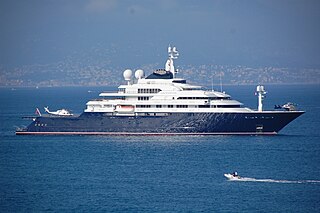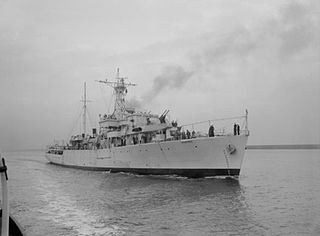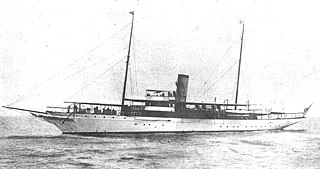
HMS Beagle was a Cherokee-class 10-gun brig-sloop of the Royal Navy, one of more than 100 ships of this class. The vessel, constructed at a cost of £7,803, was launched on 11 May 1820 from the Woolwich Dockyard on the River Thames. Later reports say the ship took part in celebrations of the coronation of King George IV of the United Kingdom, passing through the old London Bridge, and was the first rigged man-of-war afloat upriver of the bridge. There was no immediate need for Beagle, so she "lay in ordinary", moored afloat but without masts or rigging. She was then adapted as a survey barque and took part in three survey expeditions.

HMS Warrior is a 40-gun steam-powered armoured frigate built for the Royal Navy in 1859–1861. She was the name ship of the Warrior-class ironclads. Warrior and her sister ship HMS Black Prince were the first armour-plated, iron-hulled warships, and were built in response to France's launching in 1859 of the first ocean-going ironclad warship, the wooden-hulled Gloire. Warrior conducted a publicity tour of Great Britain in 1863 and spent her active career with the Channel Squadron. Obsolescent following the 1873 commissioning of the mastless and more capable HMS Devastation, she was placed in reserve in 1875, and was "paid off" – decommissioned – in 1883.

HMS Erebus was a First World War monitor launched on 19 June 1916 and which served in both world wars. She and her sister ship Terror are known as the Erebus class. They were named after the two bomb vessels sent to investigate the Northwest Passage as part of Franklin's lost expedition (1845–1848), in which all 129 members eventually perished.

HMS Attacker (D02) was an American-built escort carrier that served with the Royal Navy during the Second World War.

USS St. George (CVE-17) was laid down on 31 July 1941 as a C3-S-A2 by Ingalls Shipbuilding, Hull 296 of Pascagoula, Mississippi, under Maritime Commission contract as the (second) SS Mormacland for Moore-McCormack Lines, Inc.,. She was renamed St. George (AVG-17) by the United States Navy on 7 January 1942; and assigned to the United Kingdom under Lend-Lease as HMS Pursuer on 24 February 1942. The vessel was launched on 18 July 1942, sponsored by Mrs. Mary Ann S. Bartman. The escort carrier was reclassified ACV-17 on 20 August 1942, acquired by the US Navy and simultaneously transferred to Britain on 14 June 1943. She was reclassified CVE-17 on 15 July 1943.

HMS Eagle was an Audacious-class aircraft carrier of the Royal Navy, in service 1951–1972. Until the arrival of the Queen Elizabeth-class aircraft carriers in the 21st century, she and her sister Ark Royal were the two largest Royal Navy aircraft carriers ever built.

The Albion-class landing platform dock is a class of amphibious warfare ship in service with the Royal Navy. The class consists of two vessels, HMS Albion and HMS Bulwark, ordered in 1996 to replace the ageing Fearless class. Both ships were built by BAE Systems Marine at the former Vickers Shipbuilding and Engineering yard in Barrow-in-Furness. Albion was commissioned in 2003 and Bulwark in 2004. Each of the ships has a crew of 325 and can accommodate up to 405 troops. Thirty-one large trucks and thirty-six smaller vehicles and main battle tanks can be carried inside the vehicle deck. To disembark troops and vehicles, the vessels are equipped with eight landing craft.

Octopus is a 126-metre (413 ft) megayacht built for Microsoft co-founder Paul Allen. She is one of the world's largest yachts. Launched in 2003 at a cost of $200 million, Octopus is a private vessel that has been loaned out for exploration projects, scientific research initiatives and rescue missions.
Seven vessels of the British Royal Navy have been named HMS Bulldog, after the bulldog, with an eighth announced:

The Turbine Steamship Fairsky was a one-class Italian-styled passenger ship operated by the Sitmar Line, best known for service on the migrant passenger route from Britain to Australia from May 1958 until February 1972. After a 20-month lay-up at Southampton, Fairsky completed two further voyages to Australia, before returning to be based at Sydney as a popular full-time cruise ship, until striking an unmarked wreck in 1977 which rendered the vessel uneconomic to permanently repair. The ship was finally sold to a Philippines based consortium, intended for static use as a casino and floating hotel. In 1979 during refurbishment at Manila Bay for her new role, a fire broke out onboard which destroyed the accommodation. The wreck was towed to Hong Kong for demolition in 1980.

KD Hang Tuah is a frigate formerly operated by the Royal Malaysian Navy from 1977 until 2018. She is now a museum ship. She was built in the United Kingdom, originally for the Ghana Navy, but was launched and completed as a private venture, before being purchased by the Royal Navy in 1972. She served for five years as HMS Mermaid (F76) before being purchased by Malaysia, where she replaced another ex-British frigate also called Hang Tuah. She became a training ship in 1992 and was refitted to replace obsolete weapons and machinery.
SS Vyner Brooke was a Scottish-built steamship that was both the royal yacht of Sarawak and a merchant ship frequently used between Singapore and Kuching. She was named after the 3rd Rajah of Sarawak, Sir Charles Vyner Brooke. At the outbreak of war with Japan the ship was requisitioned by the Royal Navy, armed, and sunk in 1942.

The RMS Teutonic was an ocean liner built for the White Star Line in Belfast and was the first armed merchant cruiser.

HMS Surprise was a Bay-class anti-aircraft frigate of the British Royal Navy. In commission from 1946 to 1965, she served in the Mediterranean Fleet as a Despatch Vessel for the Commander-in-Chief. Although principally employed for the use as a yacht by the CinC, Surprise was also deployed in its operational role as an anti-aircraft frigate and was allocated to the Haifa Patrol for a brief period in 1948. The archaic term "Despatch Vessel" was replaced by "Flag Frigate" in 1961.

HMS Dalrymple was a Bay-class anti-aircraft frigate of the British Royal Navy, which served as a survey ship, mostly in the Persian Gulf, from 1948 until 1965. She was completed to deal with the large numbers of uncharted wrecks and mines around the British Isles as a result of World War II. For this purpose she was fitted for minesweeping. She was named for the pioneering Hydrographer of the Admiralty Alexander Dalrymple (1737–1808).

The harbour defence motor launch (HDML) was a 72 ft (22 m) long British-designed motor vessel used for harbour defence during World War II. Nearly 500 were built by numerous Allied countries during the war.

The Cherokee class was a class of brig-sloops of the Royal Navy, mounting ten guns. Brig-sloops were sloops-of-war with two masts rather than the three masts of ship sloops. Orders for 115 vessels were placed, including five which were cancelled and six for which the orders were replaced by ones for equivalent steam-powered paddle vessels.

USS Lydonia (SP-700) was United States Navy patrol vessel in commission from 1917 to 1919 that saw service during World War I. Prior to her U.S. Navy service, she had been William A. Lydon's private yacht, Lydonia II, from 1912 to 1917. She spent most of the war based at Gibraltar, escorting and protecting Allied ships in the Mediterranean and along the Atlantic Ocean coast of Europe. After her U.S. Navy service ended, she served from 1919 to 1947 in the United States Coast and Geodetic Survey as the coastal survey ship USCGS Lydonia (CS-302).

The Bulldog class was a four ship class of survey vessels in service with the Royal Navy from the late 1960s until the start of the 21st century. Initially designed with service overseas in mind, they spent most of their careers off the British coast. A fifth ship was subsequently built to a modified design to support them in their activities. Decommissioned and sold off at the end of the 20th and start of the 21st centuries, they have continued in service as civilian vessels, with some being converted to private yachts and others entering other commercial sectors.

HMS Canada was a Comus-class screw corvette of the Royal Navy. She was launched in 1881 and sold for scrap in 1897. Her bow badge was removed prior to being sold for scrap and is displayed in the Maritime Museum of British Columbia.


















